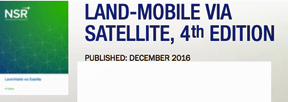
The debate over best orbit and capacity (frequency) type to provide services is ever present in the land-mobile SATCOM market.
This is especially so since FSS Ku-band operators made inroads in the last decade with higher VSAT speeds against MSS narrowband. Even before that, competition between so called Big LEO and GEO services in L-band was and still is fierce. But will this conversation further split the market and affect possible synergies between the players in GEO and new MEO/LEO systems with more and increasingly varied supply?
As more constellations and fleets operating in different orbits and frequency bands are set to play in the same sandbox in the next ten years, alongside many new types of higher performing terrestrial 5G networks, the landscape is sure to get more complex for established players. These new ‘heavy’ terrestrial actors already pose many questions especially in fixed satellite services where the interplay between SATCOM and 5G (in particular for wireless backhaul) was well laid out by NSR. It indicated enormous challenges for SATCOM but also highlighted the unique flexibility of satellite as a key enabler meaningfully contributing to the next-generation connectivity equation.
NSR Land-Mobile via Satellite 4th Edition report delves into the opportunity for land-mobile players and examines demand across non-GEO and GEO systems as the expansion of portfolios of products takes hold through synergies. It seems that offering hybrid solutions and services will characterize ecosystems for land-mobile connectivity in the coming decade. But when it comes to competing with terrestrial systems, a large part of land-mobility via satellite’s value proposition is to serve rural and "unconnected" regions, where 5G is less present.
Still, more synergies and increased flexibility to maintain or drive adoption in the face of more intense competition will be required. The recent announcement that old foes Globalstar and Inmarsat intend to cross-sell their respective products and services is clearly a step in that direction. It may be that the operators intend to merge eventually to offer a complete integrated hybrid networks like OneWeb and Intelsat plan to do, but one thing is sure: industry changes are afoot and necessary to grow with customers that are ever more demanding solutions that work, anywhere, anytime with more capabilities.
Higher bandwidth available from new systems (Iridium NEXT, Inmarsat-6 and LEO-HTS, in particular) for broadband connectivity will definitely help ARPU levels grow, thanks to more usage on a per unit basis. For one key market (comms-on-the-pause (COTP), which is a major driver for land-mobile market revenues), it will show vastly different revenue streams when looking at L-band (dominated by GEO systems such as Inmarsat) and FSS or HTS (dominated by GEO systems from Intelsat, SES). The MSS L-band offering will need to sustain their pace in the traditional market, but growth will happen faster in GEO-HTS and, to a lesser extent, non-GEO HTS. But these global non-GEO HTS broadband networks will need to have better, cheaper and smaller terminals with (likely) electronically-steered automatic pointing systems to make a dent in the market.
There's quite a lot of speculation on how new LEO HTS broadband constellations will affect established networks in the land-mobile via satellite markets. Given current plans, NSR believes that until antennas offered at a low or comparable price to current ones come into play, the legacy market is somewhat protected. What it will do, however, is push current players with new and old systems to forge more alliances and go beyond their traditional offerings to set-up portfolios across a variety of orbits and capacity types.

Author of the report and this executive summary: Claude Rousseau, Research Director, NSR France

